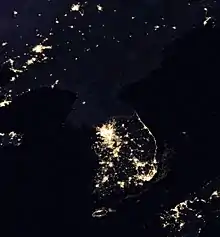Energy in North Korea
Energy in North Korea describes energy and electricity production, consumption and import in North Korea.
.jpg.webp)
North Korea is a net energy exporter. Primary energy use in North Korea was 224 TWh and 9 TWh per million people in 2009.[1] The country's primary sources of power are coal and hydro, after Kim Jong-il implemented plans that saw the construction of large hydroelectric power stations across the country.[2]
Overview

| Energy in North Korea[4] | ||||||
|---|---|---|---|---|---|---|
| Capita | Prim. energy | Production | Export | Electricity | CO2-emission | |
| Million | TWh | TWh | TWh | TWh | Mt | |
| 2004 | 22.38 | 237 | 223 | -15 | 18.50 | 70.20 |
| 2007 | 23.78 | 214 | 229 | 15 | 18.12 | 62.32 |
| 2008 | 23.86 | 236 | 242 | 6 | 19.54 | 69.37 |
| 2009 | 23.91 | 224 | 236 | 12 | 17.76 | 66.20 |
| 2012 | 24.45 | 18.21 | 64.82 | |||
| 2012R | 24.76 | 164 | 236 | 72 | 16.20 | 45.42 |
| 2013 | 24.90 | 168 | 280 | 112 | 16.44 | 47.68 |
| Change 2004-09 | 6.8 % | -5.4 % | 5.5 % | - | -4.0 % | -5.7 % |
| Mtoe = 11.63 TWh, Prim. energy includes energy losses that are 2/3 for nuclear power[5]
2012R = CO2 calculation criteria changed, numbers updated | ||||||
Per capita electricity consumption
According to statistics compiled by the South Korean agency, Statistics Korea, based on International Energy Agency (IEA) data, per capita electricity consumption fell from its peak in 1990 of 1247 kilowatt hours to a low of 712 kilowatt hours in 2000. It has slowly risen since to 819 kilowatt hours in 2008, a level below that of 1970.[6][7]
In 2017 many homes were using small standalone photovoltaic systems.[8][9] In 2019 it was estimated 55% of North Korean households used solar panels.[10]
By 2019, electricity production had reached a level where any supply blackouts were of relatively short durations.[11]
Oil imports
North Korea imports crude oil from an aging pipeline that originates in Dandong, China. The crude oil is refined at the Ponghwa Chemical Factory in Sinuiju, North Korea.[12] North Korea has a smaller oil refinery, the Sŭngri Refinery, on its Russian border. The country had been able to import oil from China and the Soviet Union for below market prices, but with the end of the Cold War, these deals were not renewed, leading to an explosive rise in oil prices for Pyongyang and a drop in imports.[13]
North Korea imports jet fuel, diesel fuel, and gasoline from two refineries in Dalian, China, which arrive at the North Korean port of Nampo.[12]
Power facilities
- Huichon Hydroelectric Power Station
- Hungju Youth Hydroelectric Power Station
- Jangjagang Hydroelectric Power Station
- Paektusan Hero Youth Power station
- Sodusu Hydroelectric Power Station
- Sup'ung Dam
- Taipingwan Dam
- Taechon Hydroelectric Power Station
- Taeryong Hydroelectric Power Station
- Wiwon Dam
- Unbong Dam
- Yongbyon Nuclear Scientific Research Center
References
- 2011 IEA Key energy statistics 2011 Archived 2011-10-27 at the Wayback Machine Page: Country specific indicator numbers from page 48
- "North Korea's Hydroelectric Power – Part I | 38 North: Informed Analysis of North Korea". 38 North. 2019-07-03. Retrieved 2019-09-09.
- "Satellite data strongly suggests that China, Russia and other authoritarian countries are fudging their GDP reports". Washington Post. Retrieved 1 September 2019.
- IEA Key World Energy Statistics Statistics 2015 Archived 2016-03-13 at WebCite, 2014 (2012R as in November 2015 Archived 2015-05-05 at WebCite + 2012 as in March 2014 is comparable to previous years statistical calculation criteria, 2013 Archived 2014-09-02 at the Wayback Machine, 2012 Archived 2013-03-09 at the Wayback Machine, 2011 Archived 2011-10-27 at the Wayback Machine, 2010 Archived 2010-10-11 at the Wayback Machine, 2009 Archived 2013-10-07 at the Wayback Machine, 2006 Archived 2009-10-12 at the Wayback Machine IEA October, crude oil p. 11, coal p. 13 gas p. 15
- Energy in Sweden 2010 Archived October 16, 2013, at the Wayback Machine, Facts and figures, The Swedish Energy Agency, Table 8 Losses in nuclear power stations Table 9 Nuclear power brutto
- Kim Tae Hong (August 6, 2012). "Economic Collapse Reflected in Scarce Electricity". Daily NK. Archived from the original on September 4, 2012. Retrieved August 6, 2012.
- "N. Korea's power consumption per capita at 1970s levels". Yonhap News. Yonhap. August 6, 2012. Archived from the original on October 22, 2014. Retrieved August 6, 2012.
- Frank, Ruediger (6 April 2017). "Consumerism in North Korea: The Kwangbok Area Shopping Center". 38 North. U.S.-Korea Institute, Johns Hopkins University School of Advanced International Studies. Archived from the original on 11 April 2017. Retrieved 10 April 2017.
- Lankov, Andrei (31 May 2017). "How North Korea 's electricity supply became one of the world's worst". NK News. Retrieved 21 October 2017.
outside walls of houses are nearly all plastered with solar panels
- Shin, Hyonhee (18 April 2019). "Cheap solar panels power consumer appliance boom in North Korea". Reuters. Retrieved 27 October 2019.
- Park Min-hee; Noh Ji-won (14 January 2019). "From darkness to light: North Koreans experience abundance of electricity for first time". The Hankyoreh. Retrieved 27 October 2019.
- Aizhu, Chen (2017-04-28). "How North Korea gets its oil from China: lifeline in question at U.N. meeting". Reuters. Retrieved 2017-09-09.
- "Can North Korea Survive An Oil Embargo?". OilPrice. 12 September 2017.
Further reading
- Ahn, Se Hyun (2013). "North Korea's Energy Conundrum: Is Natural Gas the Remedy?". Asian Survey. 53 (6): 1037–1062. doi:10.1525/as.2013.53.6.1037. ISSN 0004-4687.
External links
 Media related to Energy in North Korea at Wikimedia Commons
Media related to Energy in North Korea at Wikimedia Commons